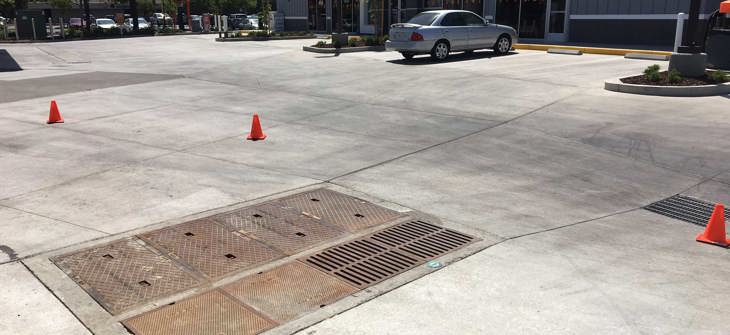
Making the Grade
There are certain hazards with any profession. For a stormwater engineer, mine takes the form of gentle teasing from friends and family as I stoop in parking lots peering down grates into the abyss.
What am I looking for? Well, like most stormwater infrastructure, nearly every Contech product is buried. My work is completely hidden underground! Almost every part, that is.
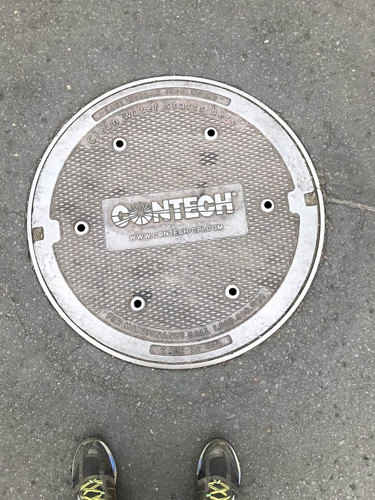
Figure 1- The author looking down at the cover to a Contech stormwater treatment system in Portland, OR.
For most systems all you see is a 24" or 30" round access point, what many people would call a "manhole cover". Typically the concrete structure itself is buried anywhere between a few inches and several feet underneath the pavement. This article will discuss the connection between the cover and the buried structure and the range of options available to a design engineer.
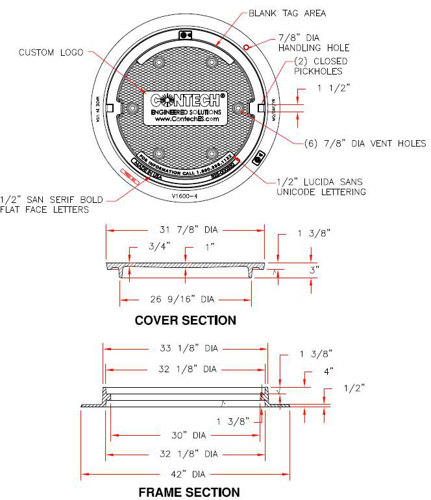
Figure 2 - Contech's standard 30" frame and cover made domestically by EJ (formerly East Jordan) features a reversible frame that can be used in different orientations to fit site constraints.
Most access points take the form of a round frame and cover made from gray or ductile iron. The frame is a ring that serves as a support on which the cover sits. To access the system for maintenance or inspection, one removes the cover using a hook or other device.
Option 1 (typical)
The configuration that is typical for most sites and familiar to contractors and precasters has the wide flange side oriented down as shown. The 30" model would be placed above a 30” diameter hole in the top of the stormwater structure. They would be connected by non-shrink grout, and if required, precast concrete grade rings. See the example drawing below of a Stormwater Management StormFilter® with 30” frames and covers; the covers on the left end of the unit use this typical configuration.

Figure 3 - A Stormwater Management Stormfilter® in San Antonio, TX that was designed to be partially located in a paved area and partially in a landscaped area. The frame over the filtration bay (right) is cast into the top slab to match the pavement elevation. The frames over the inlet and outlet bay (left) are just above curb height.
Contech’s standard traffic rated frames are 4 inches deep and it is typical to have a couple of inches of grout to allow for field adjustment. Therefore, the minimum height of cover with this configuration is 5 to 6 inches. That could be extended to approximately two feet with grade rings. However, since the grade rings are minimally reinforced, deeper cover over a structure should be seen as a red flag. Reinforced precast risers, such as manhole sections or box culvert sections, could be good substitutes.
Option 1 offers maximal field adjustability since an installer can use grade rings and the depth of grout to match the top of casting to finished grade. However, it requires sufficient depth because some available vertical space is given over to the slack between the top of structure and finished grade. This option also minimizes what can be seen from the surface, so designers prefer this configuration for landscaped areas where aesthetics are a primary consideration.
Option 2 (“reversed casting” or “flipped casting”)
Many systems are shallow and the designer does not have the room for deep burial. In this configuration, the flange side of the frame is up, which is flipped 180° from option 1. A larger, 34” hole is made in the top slab to accommodate the outer diameter of the frame. At installation, the frame can then be slid up and down within a few inch range to match finished grade, and the frame is grouted in place. In the end, only the flange and cover are visible at the surface.
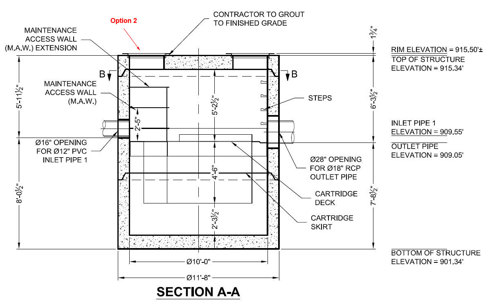
Figure 4- This Jellyfish filter has "flipped castings" with the flange flush with grade. The 34" opening allows the frame to be field-adjusted and grouted in place.
This option is a compromise between option 1 above and option 3 below. The primary advantage of this design is that allows for some field adjustment in situations with minimal cover. It also allows the installer to match a grade that slopes across a structure’s multiple access points.
However, “flipped castings” have some limitations. The adjustability is only a couple of inches since it is constrained by the frame depth. The section depth above the structure is similarly limited. So, designers and installers should pay attention to pavement design to ensure the shallow burial depth is acceptable.
Option 3 (“flush mounted” or “cast-in”)
If site constraints require the top of unit to be flush with grade, the frame can be cast directly into the top slab. As with Option 2, the flange side is oriented up. The frame is placed in the form when the top slab is poured at the precaster, and it will be fixed in the concrete.
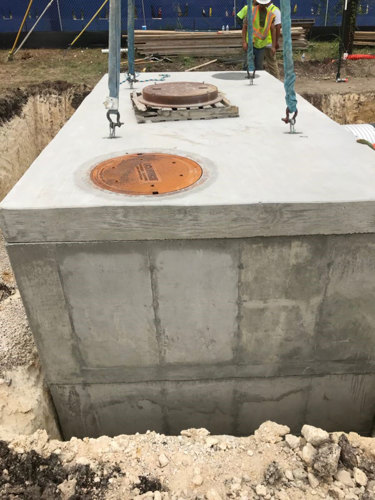
Figure 5- A photograph of the example Stormfilter from above. Notice the flush-mounted frame and cover in the foreground. The palletized frame in the background will later be installed above the circular top slab opening further in the background.
Designers should note that the top slab of the structure will be the finished grade. This has a number of drawbacks. There is no flexibility to adjust the elevation of the top slab, so the installer will likely be adjusting surrounding surfaces to match it. If aesthetics are important, the exposed top slab may not be desirable. For example, if an asphalt pavement is specified, the concrete top slab surface will stand out. Finally, since the top slab is exposed, the precaster will usually broom finish the concrete surface to improve traction.
I hope this article has piqued your interest in buried stormwater structures. Even if you are not moved to start braving traffic to inspect manhole covers, I expect you are more aware of some design issues. If, on the other hand, this topic seemed overwhelming, please know that for many systems with no special constraints, designers can ignore the design of the access points.
Then again, every site is different. So, while the three options above will address the needs of most designs, there is a world of hatches, riser slabs, covers for non-standard loading, trench covers, and CMP risers that will go unaddressed. If you have a project that needs to “make the grade”, please reach out to your Contech Stormwater Design Engineer who will happily assist you finding the right solution.
